Slow-Roasted Salmon with French Herb Salsa
- By Jennifer Segal
- Updated April 3, 2025
- 328 Comments
- Leave a Review

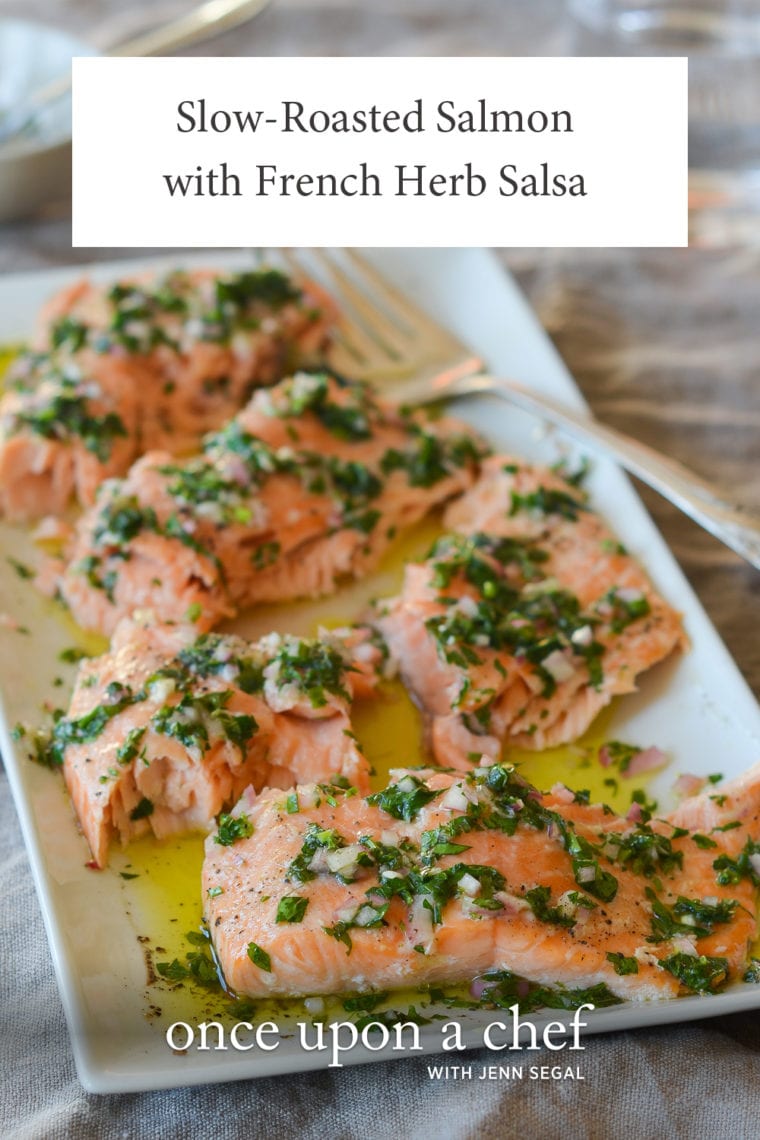
This post may contain affiliate links. Read my full disclosure policy.
Want to impress your guests without stressing? This slow-roasted salmon with fresh herb salsa looks impressive, tastes amazing, and couldn’t be easier. Serve it warm, chilled, or at room temp—whatever works for you.
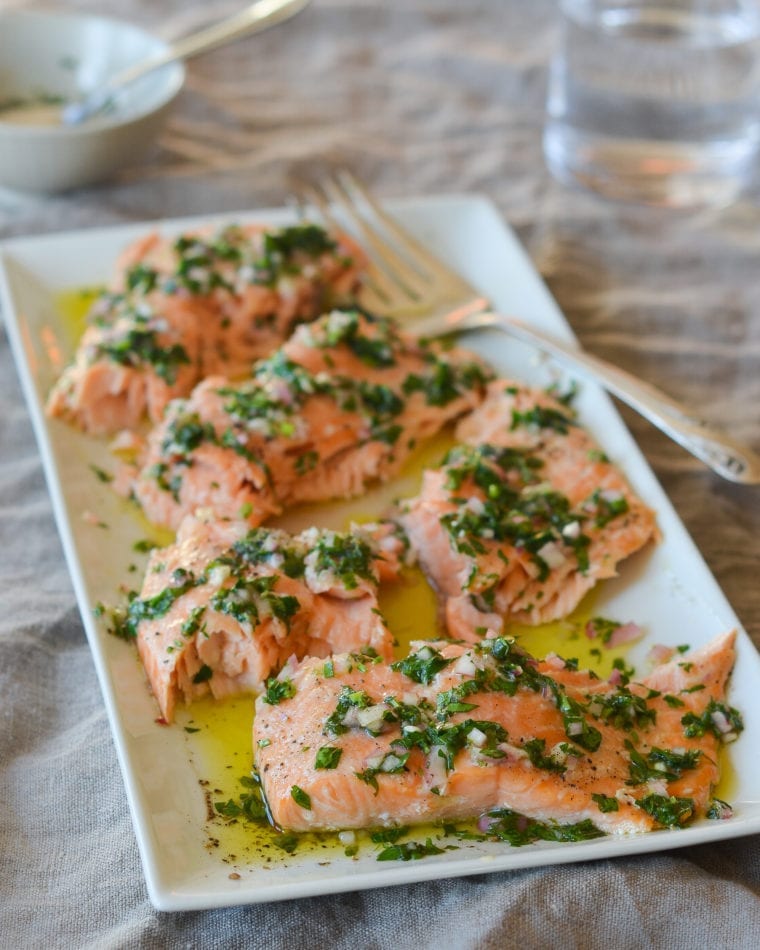
This slow-roasted salmon recipe, a gem from Samin Nosrat’s acclaimed Salt, Fat, Acid, Heat, has become a favorite in my kitchen. Her method is brilliant—roasting the salmon low and slow makes it almost impossible to overcook the fish. It stays super moist and just a little translucent, even when it’s fully cooked. Like a lot of Samin’s recipes, this one’s more of a technique than a strict formula, and she includes a few variations and sauces to play around with.
I usually serve it with a simple herb salsa—just macerated shallots, olive oil, and a mix of soft herbs. It takes no time at all and adds so much flavor.
You can serve the salmon warm, cold, or at room temp (that’s my favorite), and it always feels a little fancy, especially on a holiday buffet. It’s delicious alongside roasted potatoes, a simple green salad, or roasted asparagus. The fact that you can make it ahead is a huge bonus when you’re hosting.
“So tender – melt in your mouth. The sauce is excellent. Incredibly simple yet beautiful presentation. My new go to salmon recipe.”
What you’ll need To Make Slow-Roasted Salmon
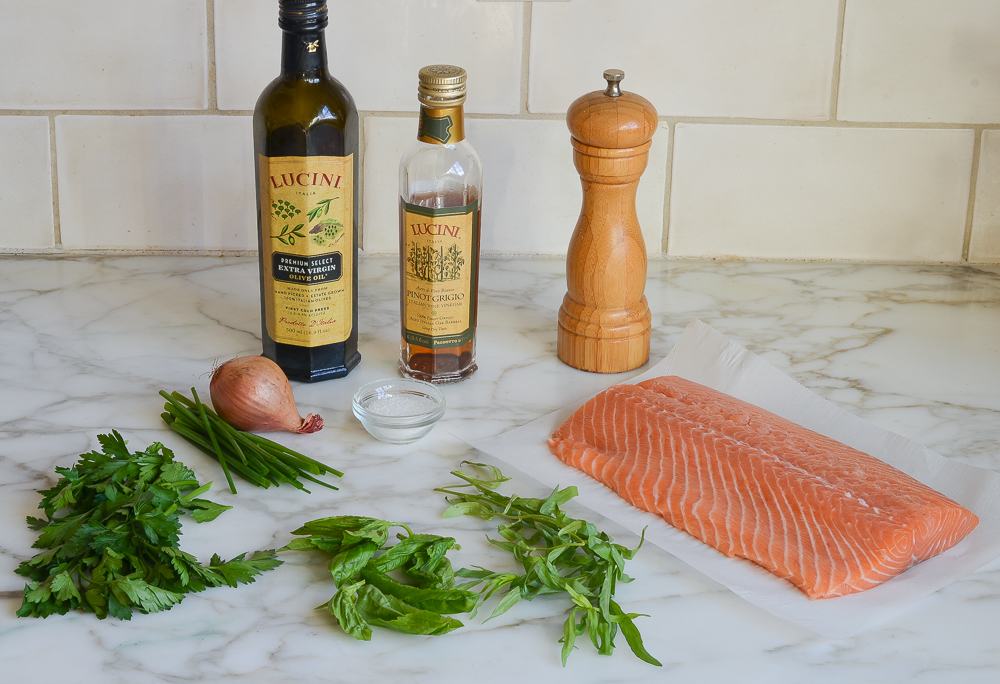
- Salmon Filet: You can ask your fishmonger to remove the skin for convenience. If you don’t, it’s easy to remove once the salmon is cooked; just slide a thin metal spatula between the flesh and skin when serving.
- Extra-Virgin Olive Oil: Used to coat the salmon for moisture and richness, and as the base for the herb salsa.
- Shallot: Adds a mild, slightly sweet onion flavor to the salsa.
- White Wine Vinegar: Provides bright acidity to balance the richness of the salmon and round out the salsa.
- Fresh Italian Parsley, Chervil, Chives, Basil, And Tarragon: A blend of fresh herbs that gives the salsa its bright, fresh flavor and loads of aroma.
- Jump to the printable recipe for precise measurements
Step-by-Step Instructions
Step 1. Prep the salmon. Place the salmon on a baking sheet, drizzle with olive oil, and sprinkle evenly with salt.
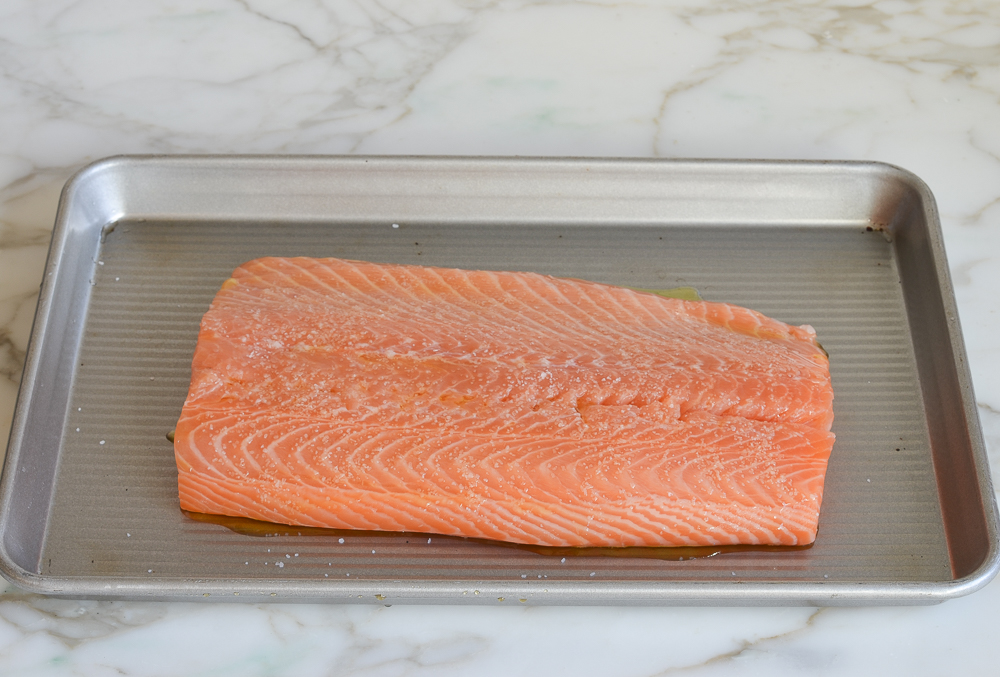
Step 2. Roast the salmon. Roast for 40 to 50 minutes in a 225°F oven until the thickest part flakes easily when pressed with a knife or your finger. It will still look a little translucent even when fully cooked.
Pro Tip: Slow-roasting keeps the fish tender, prevents it from seizing up, and reduces the amount of white protein (albumin) that surfaces. If you see a bit (like below), simply scrape it off with a spoon.

Step 3. Macerate the shallots. In a small bowl, combine the shallot and vinegar and let sit for 15 minutes.
Pro Tip: Macerating mellows the sharp bite of the shallot and enhances its natural sweetness.
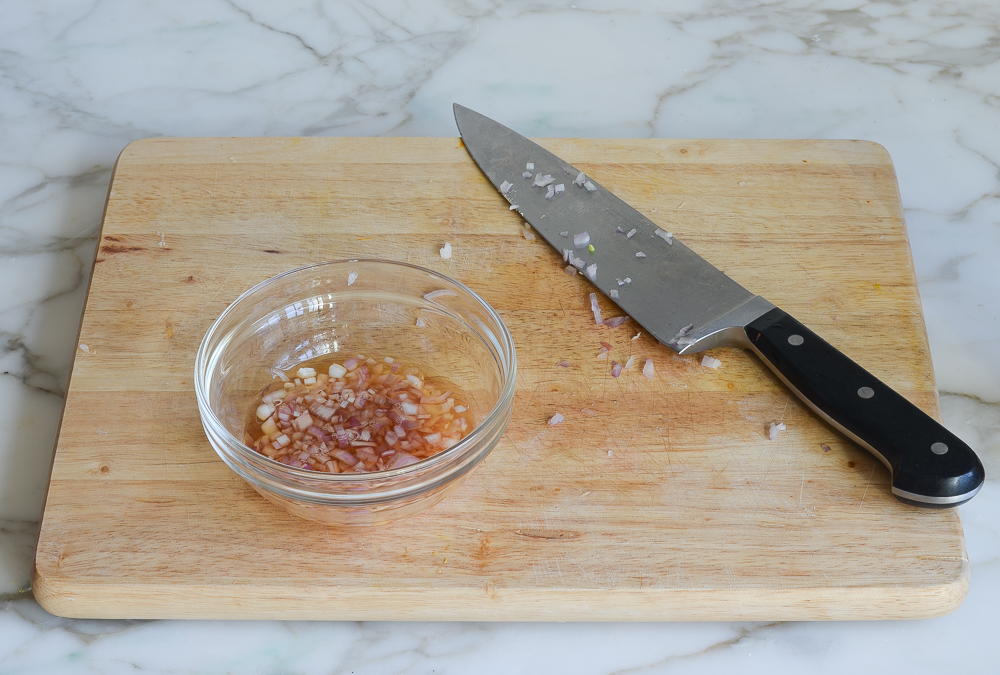
Step 4. Make the herb oil. In another bowl, mix the herbs, olive oil, salt, and black pepper.
Pro Tip: Chop the herbs as finely as possible so their essential oils release and flavor distributes evenly.
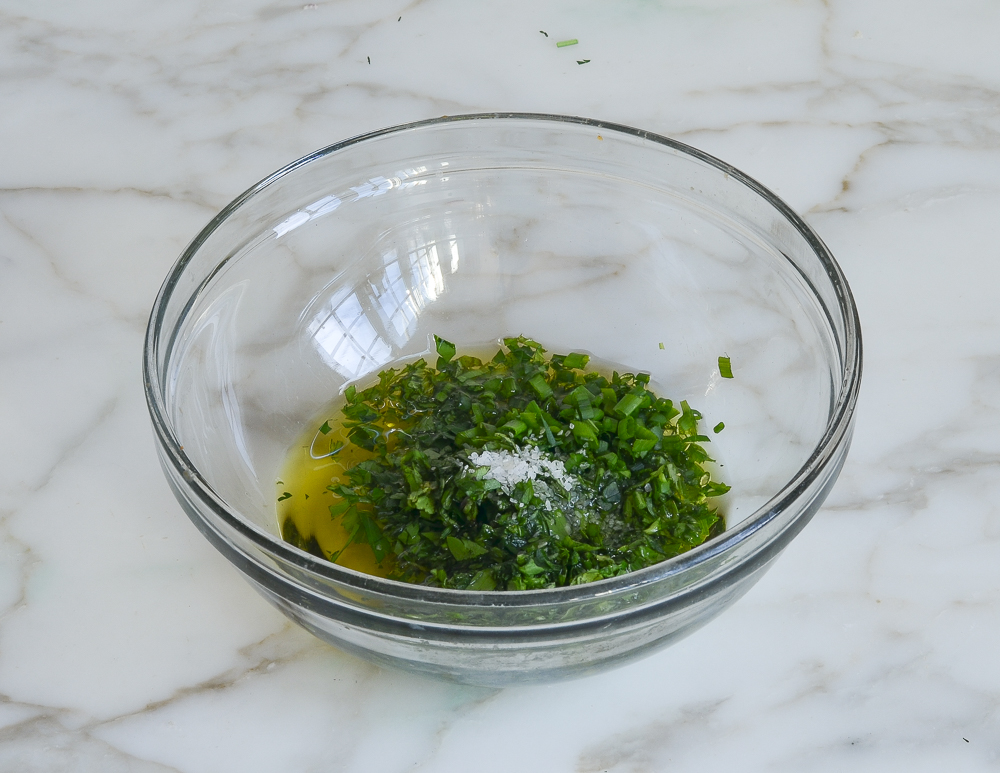
Step 5. Finish the salsa. Right before serving, use a slotted spoon to transfer the shallots (without the vinegar) into the herb oil. Stir, then taste and add 2 to 3 teaspoons of the vinegar, depending on how sharp the flavor is. Adjust salt if needed.
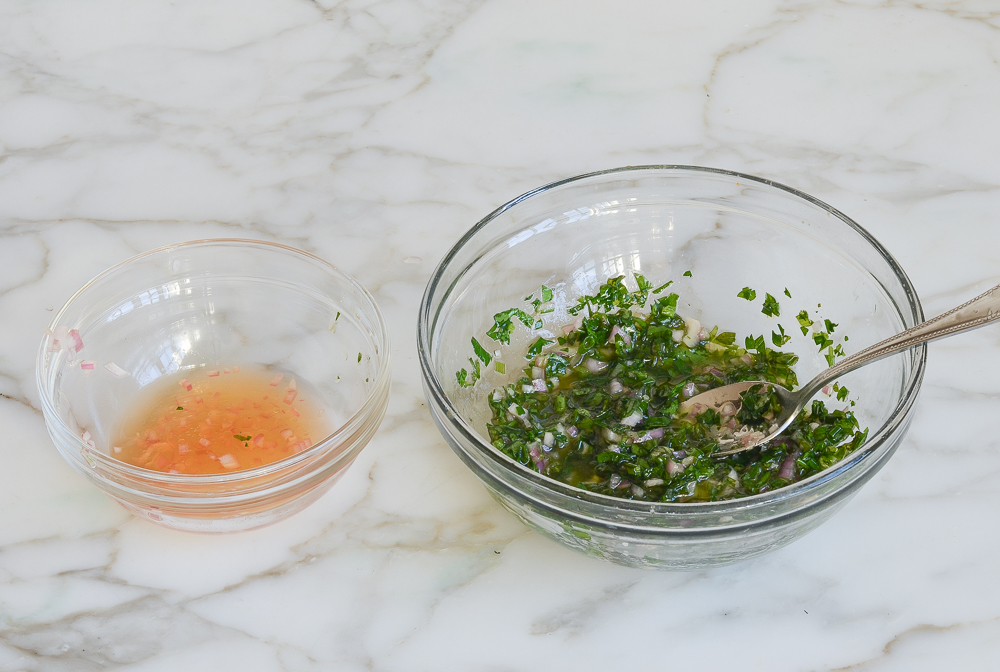
Step 6. Break and serve the salmon. Break the salmon into rustic pieces, spoon the herb salsa over the top, and serve.
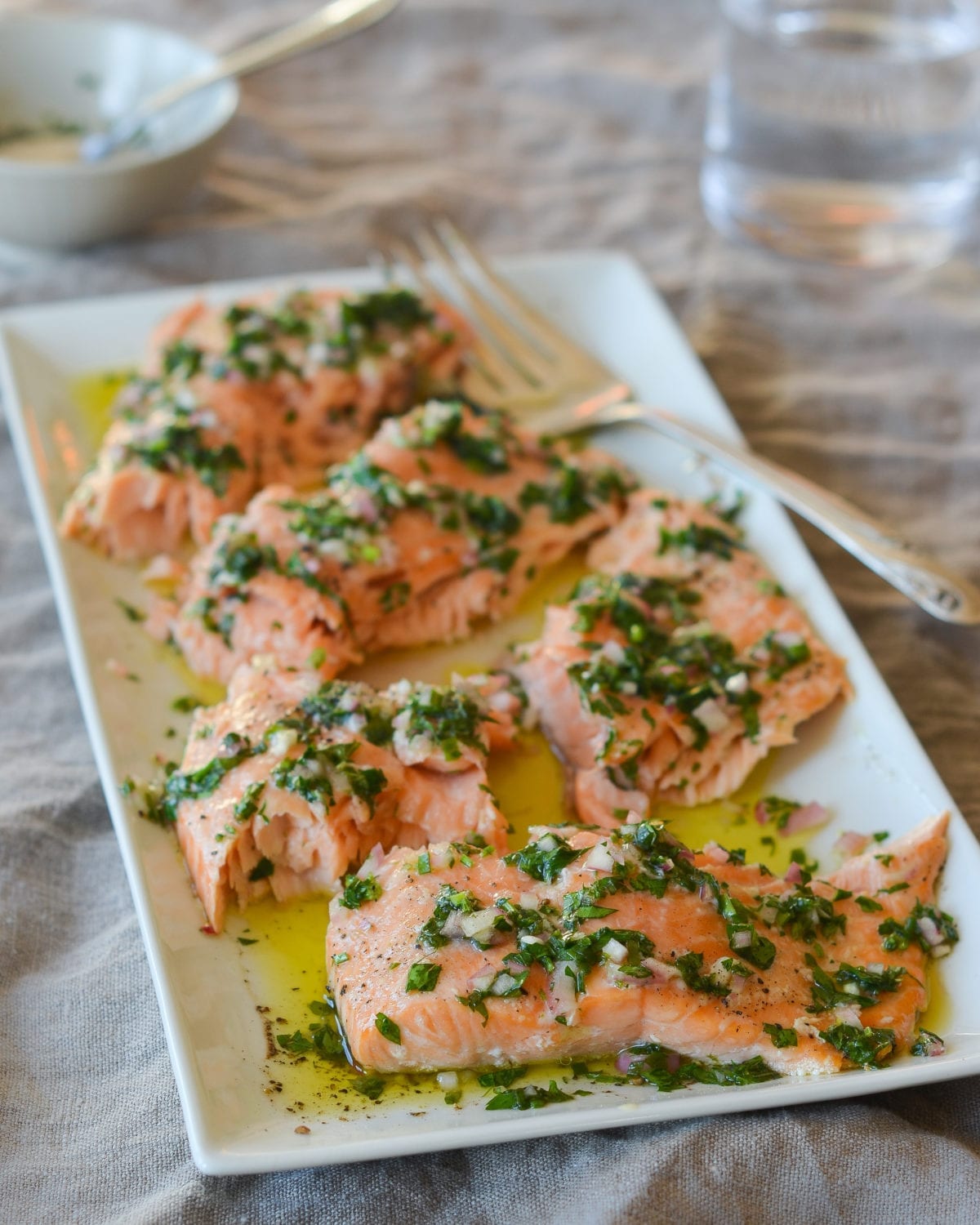
The salmon can be roasted a day ahead and refrigerated, and the salsa can be made up to two days in advance and chilled until ready to use.
More Salmon Recipes You may like
Slow-Roasted Salmon with French Herb Salsa
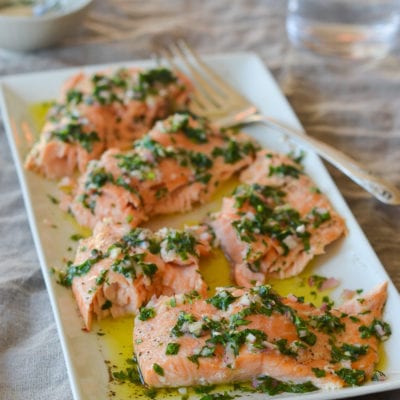
Ingredients
For the Salmon
- 1 (2-lb) salmon filet, pin bones and skin removed
- 1 tablespoon extra-virgin olive oil
- ¾ teaspoon kosher salt
For the French Herb Salsa
- 3 tablespoons finely diced shallot, from 1 medium shallot
- 3 tablespoons white wine vinegar
- 2 tablespoons very finely chopped fresh Italian parsley
- 1 tablespoon very finely chopped fresh chervil (okay to substitute more parsley if you can't find it)
- 1 tablespoon very finely chopped fresh chives
- 1 tablespoon very finely chopped fresh basil
- 1 teaspoon very finely chopped fresh tarragon
- 5 tablespoons extra-virgin olive oil
- ¼ teaspoon kosher salt
- Freshly ground black pepper
Instructions
For the Salmon
- Preheat the oven to 225°F (105°C) and set an oven rack in the middle position.
- Place the salmon on a baking sheet. Drizzle with the olive oil and sprinkle the salt evenly over top. Slide the pan into the oven and roast for 40 to 50 minutes, until the fish begins to flake in the thickest part of the filet when poked with a knife or your finger. (Because this method is so gentle on its proteins, the fish will appear translucent even when it's cooked.) Using a small spoon, scrape off any white coagulated proteins that may have formed on the salmon.
- Break the salmon into large, rustic pieces and spoon the French herb salsa (below) over top. This dish can be served hot, cold, or room temperature.
For the French Herb Salsa
- In a small bowl, combine the shallot and vinegar and let sit for 15 minutes to macerate.
- In a separate small bowl, combine the herbs, olive oil, salt, and a few grinds of black pepper.
- Just before serving, use a slotted spoon to add the shallot (but not the vinegar, yet) to the herb oil. Stir, taste, and add the vinegar as needed (I usually add 2 to 3 teaspoons). Taste and adjust salt, if necessary.
Notes
Nutrition Information
This website is written and produced for informational purposes only. I am not a certified nutritionist and the nutritional data on this site has not been evaluated or approved by a nutritionist or the Food and Drug Administration. Nutritional information is offered as a courtesy and should not be construed as a guarantee. The data is calculated through an online nutritional calculator, Edamam.com. Although I do my best to provide accurate nutritional information, these figures should be considered estimates only. Varying factors such as product types or brands purchased, natural fluctuations in fresh produce, and the way ingredients are processed change the effective nutritional information in any given recipe. Furthermore, different online calculators provide different results depending on their own nutrition fact sources and algorithms. To obtain the most accurate nutritional information in a given recipe, you should calculate the nutritional information with the actual ingredients used in your recipe, using your preferred nutrition calculator.
Gluten-Free Adaptable Note
To the best of my knowledge, all of the ingredients used in this recipe are gluten-free or widely available in gluten-free versions. There is hidden gluten in many foods; if you're following a gluten-free diet or cooking for someone with gluten allergies, always read the labels of your ingredients to verify that they are gluten-free.
Comments
Add a Comment Cancel reply
This site uses Akismet to reduce spam. Learn how your comment data is processed.
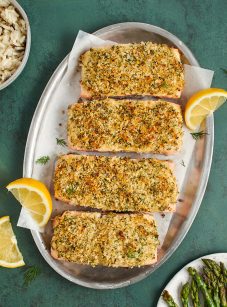
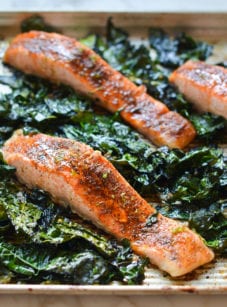
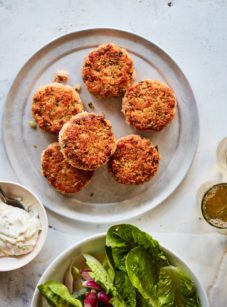
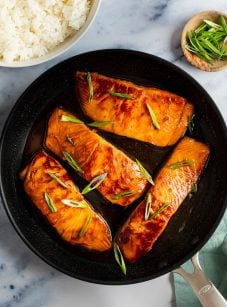
FIVE STARS!! Made this for New Year’s Day and it was a big hit. It’s so versatile and can be used for more than holidays.
Moist & delicious. Made Asian inspired dressing w/soy & fish sauce, OJ & lime juice, rice wine, garlic & ginger w/a splash of sesame oiL + a touch of brown sugar.
I *love* salmon and have it a number of times a week. Coming from the (up there!) north of Sweden, I have a number of traditional dishes I make but salmon works so well with all kinds of cuisines.
Have never seen this slow roast way to cook salmon before. Very interesting!!
Can’t wait to try it out!
Hi Jenn,
Happy New Year and thank you for all your wonderful recipes! Silly question, what would happen if I let the shallots macerate in the vinegar for longer than 15 minutes? Looking forward to trying this dish as well…I’m sure it is amazing!
Hi Stacey, They will just be a little more pickled – it will be fine.
Love your recipes! Can the salsa be made ahead of time? The day before, even?
Hi Tara, Yes it keeps well for a day or two.
Hi Jenn, would the cook time be the same or adjusted if doing a smaller piece of salmon? Thanks!
Hi Cathy, You’d definitely need to reduce the cooking time for a smaller piece of salmon.
What do you think about doing this with frozen 6oz sockeye salmon pieces?
Hi Sue, I tried this with individual 6-oz portions and found they cooked much faster. It should work, just start checking after 20 min.
Thanks!
Hi Jen:
I see the salmon filet in your picture is not too thick –looks like 1″ max. If I have thicker filet will the slow roasting technique/temperature still work? If the filet is thicker and already pre-sliced to portion sizes, will the slow roasting technique/temperature still work? In either case, if technique is still sound, should I expect it to take more time to roast, and how much more?
As luck would have it, I have 7 lb of wild king salmon on order for our New Years Eve dinner!
Also, I do love your blog. It has been very helpful to me in making foods adventuresome enough to keep my 6-year-old kids’ palates expanding, but not so wild that they don’t try the food.
Thanks for the advice,
Kate
Hi Kate, Glad your family is enjoying the recipes! The technique will still work if the salmon is pre-sliced into portions, it will take significantly less time to cook. I’d start checking after 25 min. Hope you enjoy it!
Hello, I love your blog. It’s my favorite go-to for new recipes.
Do I just need more coffee this morning (rhetorical question) or have you omitted the oven temperature for roasting the salmon?
Hi TK, Ha! It’s 225°F – you’ll find it in the first line of the recipe, under “For the Salmon.”
I scrolled up and down several times, looking for the oven temp in the early section with the pictures. You would be doing us a favor if you added the 225 to the sentence that begins “Slide the pan into the oven, which has been preheated to 225 degrees…”
Done!
Hi Jen
I love your simple and descriptive recipes. What will be side dish with so flavorful roasted salmon.
Thanks
Poonam
Hi Poonam, It depends – will you be serving it for dinner, brunch, or lunch?
Suggestion for both please !
For brunch, this would pair really nicely with quiche or strata, fruit salad, and something sweet, like banana bread. For dinner, I’d serve it with steamed or grilled asparagus or haricots verts, and roasted or steamed baby potatoes. Hope that helps!
We’re definitely trying this recipe, Jenn never lets us down! I’ll be serving it simply with parsley new potatoes or small red potatoes and green beans!
Hmmm… where’s the reference to Samin Nosrat. This is copied verbatim from her book Salt, Fat, Acid, Heat.
Hi Travis, I mention her and her series in the first paragraph of the recipe. Hope you enjoy if you make the salmon!